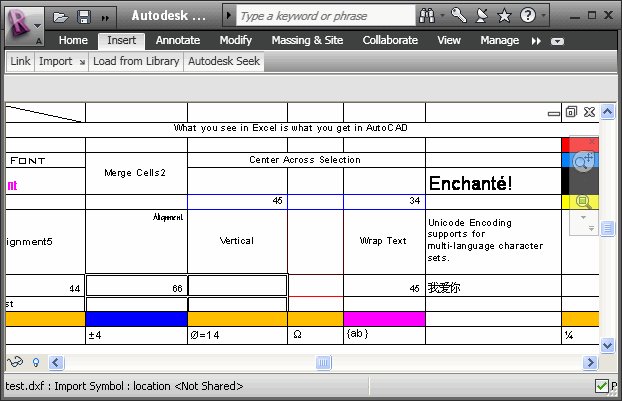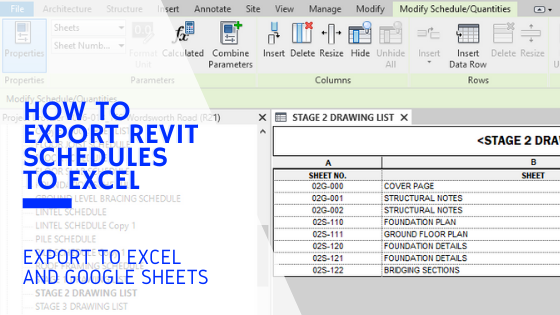Breaking Obstacles: Excel Importation Techniques for Advanced Revit Users
Explore numerous data importation approaches and master Excel combination to boost your Revit modeling capacities. With our techniques and tips, you can get rid of importation challenges and end up being a true professional in utilizing Excel for your Revit tasks.
Advanced Revit Users: Leveraging Excel for Importation
You can quickly leverage Excel for importation as an innovative Revit individual. Excel is a powerful device that can substantially boost your process and efficiency in Revit. With its capability to handle huge amounts of data and execute intricate estimations, Excel can be an useful property in managing and organizing your task information.
One method to take advantage of Excel for importation is by using the "Link Excel" attribute in Revit. This feature allows you to link an Excel spread sheet straight into your Revit job, enabling you to update and synchronize information in between the 2 programs. When dealing with routines or tracking adjustments in your task., this can be specifically useful.
Another means to utilize Excel is by making use of the "Import/Export" feature in Revit. This feature permits you to import and export information between Revit and Excel, offering you the adaptability to work with data in both programs. You can import information from Excel right into Revit to create elements such as doors, rooms, or walls, and you can also export data from Revit to Excel for additional analysis or reporting.

Exploring Data Importation Methods in Revit Using Excel
Exploring how to import data from Excel into Revit provides reliable approaches for incorporating details. When you import information from Excel, you can flawlessly move information such as space routines, material lists, and tools information right into your Revit task. This procedure enables you to save effort and time by preventing hands-on data access.
To import information from Excel into Revit, you can utilize the "Import/Export" feature. This attribute allows you to map the Excel information areas to the equivalent Revit specifications, making sure that the info is properly assigned within the model. By picking the appropriate import options, you can regulate exactly how the data is imported and how it communicates with your project.
Another method for importing data from Excel into Revit is by utilizing Dynamo. Dynamo is an aesthetic shows device that integrates with Revit and allows you to automate tasks and workflows. With Dynamo, you can develop personalized scripts that import data from Excel and adjust it within your Revit task. This technique provides also much more flexibility and customization alternatives.
Understanding Excel Combination for Advanced Revit Modeling
One essential strategy is importing information from Excel spreadsheets directly right into your Revit version. With a few straightforward steps, you can map the Excel columns to the matching Revit criteria and import the information accurately.
Another beneficial approach is exporting information from Revit to Excel. This enables you to draw out info from your version, such as timetables or material quantities, and examine it in Excel making use of formulas, charts, or various other powerful tools. By leveraging the abilities of Excel, you can do intricate calculations, create custom-made reports, and gain useful understandings right into your project.
In enhancement to data transfer, Excel integration can automate repetitive tasks in Revit. By producing macros or manuscripts in Excel, you can automate procedures like creating views, creating sheets, or using conventional households - revit add ins. look at more info This not just conserves time but additionally makes certain uniformity throughout your task
To master Excel combination in Revit, it is vital to comprehend the data framework and exactly how Revit communicates with Excel. By familiarizing on your own with the offered devices and methods, you can unlock the full capacity of Excel integration and take your Revit modeling to the next level.
Conquering Importation Difficulties: Excel Techniques for Revit Experts
When getting rid of importation challenges, it is necessary to be acquainted with reliable Excel methods that can benefit specialists in Revit. As a sophisticated Revit individual, you understand the relevance of effortlessly importing data from Excel check my site right into your jobs. You might come across different challenges along the means. By using efficient Excel strategies, you can conquer these obstacles and improve your performance.

An additional beneficial strategy is utilizing the "Transpose" feature in Excel. This enables you to transform data from rows to columns or the other way around. When importing information into Revit, this can be especially helpful when you have data in an upright layout in Excel, however you require it to be in a horizontal style in Revit.
Additionally, making use of Excel formulas such as VLOOKUP and INDEX-MATCH can substantially help in mapping information from Excel to Revit. These solutions allow you to look for details values in Excel and get matching data from another column. This can conserve you effort and time when importing huge datasets into Revit.
Excel Data Importation Advice for Advanced Revit Users
By familiarizing yourself with efficient Excel methods and tips, you can boost your information importation procedure as an innovative individual of Revit. Furthermore, revit plugins using Excel's "Paste Unique" function enables you to paste data from Excel into Revit while keeping format, such as cell color or font design. One more valuable trick is to make use of Excel's "Locate and Replace" function to promptly make modifications to your data prior to importing it into Revit.
Conclusion
You have actually now found out useful methods for importing information from Excel into Revit as an advanced customer. By leveraging the power of Excel integration, you can simplify your modeling process and get over any kind of importation challenges that might develop. With these tricks and pointers, you will have the ability to understand data importation and enhance your Revit abilities. Go in advance, break those obstacles and excel in your Revit projects!

When importing information right into Revit, this can be particularly handy when you have data in a vertical layout in Excel, but you require it to be in a straight format in Revit.
In addition, utilizing Excel solutions such as VLOOKUP and INDEX-MATCH can significantly assist in mapping information from Excel to Revit. In addition, using Excel's "Paste Special" function enables you to paste information from Excel right into Revit while maintaining formatting, such as cell shade or font design.